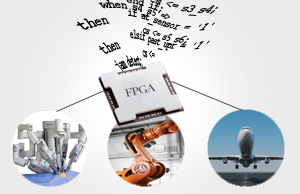
Phase Correlation IP
Phase Correlation is the same as cross correlation, just computed differently. Instead of performing a convolution of two signals to obtain the cross correlation, with phase correlation the two signals are transformed into the frequency domain via an FFT and then multiplied together element wise. The magnitude is normalized and then the inverse FFT is applied.
The result is a peak (or peaks if there are multiple instances of the the template in the search signal) at the location where the two signals correlate. This peak indicates the translative offset between the two images.
One advantage of phase correlation over cross correlation is the result is less susceptible to certain types of noise, occlusions, and other defects typical of medical or satellite images. But the biggest advantage is the speed with which this computation can be performed versus the normal cross correlation.
The phase correlation IP core is highly integrated into Touit's FFT architectures. It makes use of the same memories and complex multipliers to perform the multiplication stage of the algorithm.
Available in both 1D and 2D scalable power of two sizes, for FPGA or ASIC. Very fast and very efficient implementation.
Contact Touit with your requirements and we will provide specific implementation options.




